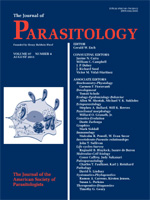In total, 462 tadpoles and salamander larvae of 8 species were examined for the presence of Gyrinicola batrachiensis from 5 locations in Nebraska. Infection by G. batrachiensis occurred in tadpoles of Rana blairi, Rana catesbeiana, Rana pipiens, and Bufo woodhousii. Tadpoles of Hyla chrysoscelis, Spea bombifrons, and Pseudacris maculata and larvae of Ambystoma mavortium were not infected with G. batrachiensis. Population structure, defined as prevalence, mean abundance, and mean intensity of G. batrachiensis, varied among tadpoles of different amphibian species and was determined by collection locality, developmental period of tadpole hosts, amphibian species co-occurrence, and different reproductive strategies of G. batrachiensis, or a combination. Gyrinicola batrachiensis observed in all ranid tadpoles and B. woodhousii tadpoles from where bufonids were the only anuran species present, confirmed to the didelphic haplodiploidy and monodelphic parthenogenetic reproductive strategies, respectively. However, tadpoles of B. woodhousii that co-occurred with tadpoles of R. pipiens at Cedar Creek were inconsistent with these predictions and contained both male and didelphic female nematodes, but at a low mean intensity (1.61 ± 0.70). Didelphic female nematodes from B. woodhousii tadpoles at Cedar Creek only produced thick-shelled eggs, whereas nematodes in R. pipiens tadpoles had a high mean intensity (14.88 ± 23.83) from this location and contained both thick-shelled and thin-shelled eggs in their respective uteri. More importantly, adult female nematodes from tadpoles of R. pipiens and B. woodhousii from Cedar Creek were morphologically more similar to each other than to female nematodes recovered from tadpoles of other anuran species, other locations, or both. These data suggest that when strains of G. batrachiensis are shared by tadpoles of different amphibian species that differ in developmental period, the nematodes have an intermediate reproductive strategy in amphibian species, with tadpoles having short development.
How to translate text using browser tools
1 August 2011
Distribution and Reproductive Strategies of Gyrinicola batrachiensis (Oxyuroidea: Pharyngodonidae) in Larvae of Eight Species of Amphibians From Nebraska
Heather R. Rhoden,
Matthew G. Bolek
ACCESS THE FULL ARTICLE

Journal of Parasitology
Vol. 97 • No. 4
August 2011
Vol. 97 • No. 4
August 2011




